Global Hematology Oncology Market, By Treatment Type, By Disease Type, By Route of Administration, By End User, By Region & Segmental Insights Trends and Forecast, 2024 – 2034
- Industry: Healthcare
- Report ID: TNR-110-1196
- Number of Pages: 420
- Table/Charts : Yes
- July, 2024
- Base Year : 2024
- No. of Companies : 10+
- No. of Countries : 29
- Views : 10132
- Covid Impact Covered: Yes
- War Impact Covered: Yes
- Formats : PDF, Excel, PPT
Hematology oncology refers to the branch of medicine focused on the diagnosis, treatment, and prevention of blood disorders and cancers. It encompasses a wide range of conditions, including leukemias, lymphomas, multiple myeloma, and various other hematologic malignancies. The field is crucial for its integration of diagnostic technologies, therapeutic advancements, and supportive care strategies tailored to improving patient outcomes and quality of life.
The hematology oncology market is poised for significant growth driven by several factors. Key trends include advancements in targeted therapies and immunotherapies, which offer more effective and personalized treatment options. Rise in research and development activities aimed at discovering novel biomarkers and therapeutic targets is expanding the market’s scope. Opportunities abound in emerging markets where healthcare infrastructure is improving, leading to greater access to specialized treatments.
Growth drivers include increasing incidences of hematologic cancers globally, aging populations prone to blood disorders, and ongoing investments in biotechnological innovations. The market’s evolution towards precision medicine and the integration of digital health solutions also present avenues for future expansion and efficiency in patient care delivery.
In Terms of Revenue, the Global Hematology Oncology Market was Worth US$ 10.5 Bn in 2023, Anticipated to Witness CAGR of 8.1% During 2024 – 2034.
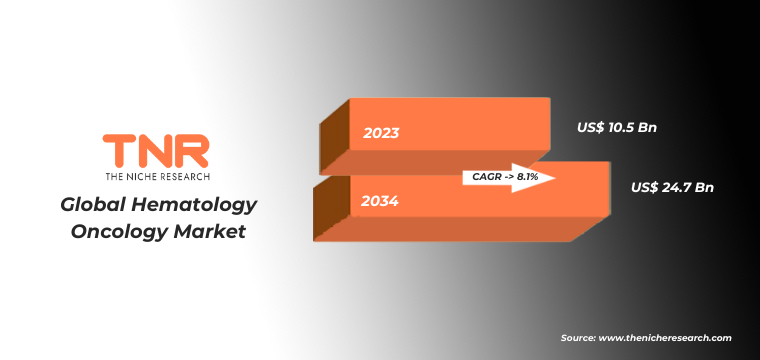
Trends in the Global Hematology Oncology Market
- Precision Medicine and Biomarker Research: The shift towards precision medicine is transforming how hematologic cancers are diagnosed and treated. Increasingly, healthcare providers are utilizing molecular diagnostics and genetic profiling to identify specific biomarkers that influence treatment decisions. This personalized approach enables targeted therapies that are more effective and less toxic compared to traditional chemotherapy. Advances in genomics, proteomics, and bioinformatics are driving this trend, allowing for more accurate patient stratification and the development of tailored therapies tailored to individual patient profiles. For instance, in April 2023, Illumina partnered with Kartos Therapeutics to expand the adoption of its genomic profiling test for hematologic malignancies. The collaboration aims to establish a universally recognized test that can be distributed globally to precision oncology providers. Illumina’s initiative reflects its commitment to advancing personalized medicine in the treatment of blood cancers, offering standardized testing solutions that enhance diagnostic accuracy and treatment efficacy for healthcare providers worldwide.
- Advancements in Immunotherapy: Immunotherapy has revolutionized cancer treatment by harnessing the body’s immune system to fight cancer cells. This approach, including monoclonal antibodies, checkpoint inhibitors, and CAR-T cell therapies, is increasingly becoming a standard of care for many hematologic malignancies. Ongoing research continues to refine these therapies, enhancing their efficacy, reducing side effects, and expanding their application across various types of blood cancers. For instance, in June 2022, Thermo Fisher Scientific Inc. broadened its range of automated tests for connective tissue diseases with the introduction of the EliA RNA Pol III and EliA Rib-P blood tests. These new offerings are designed to aid in the diagnosis of Systemic Sclerosis and Systemic Lupus Erythematosus (SLE). The release of these tests’ underscores Thermo Fisher Scientific’s commitment to enhancing diagnostic capabilities in the field of autoimmune disorders, providing healthcare professionals with advanced tools to support accurate and timely diagnosis for improved patient care.
Immunotherapy by treatment category has emerged as a dominant segment in the global hematology oncology market due to its transformative impact on cancer care.
Unlike traditional treatments like chemotherapy, which broadly target rapidly dividing cells, immunotherapy harnesses the body’s immune system to specifically recognize and attack cancer cells. This approach includes monoclonal antibodies, immune checkpoint inhibitors, and CAR-T cell therapies, each tailored to enhance the body’s natural defences against cancer. The efficacy of immunotherapy in treating hematologic malignancies such as lymphomas, leukemias, and multiple myeloma has driven its rapid adoption. Ongoing research continues to refine these therapies, optimizing their effectiveness, reducing adverse effects, and expanding their application across various types of blood cancers, thus solidifying immunotherapy’s pivotal role in shaping the future of hematology oncology treatments.

In 2023, the lymphoma segment solidified its position as the second-largest category within the global hematology oncology market, reflecting its significant impact on healthcare and treatment strategies.
Lymphomas are cancers that originate in the lymphatic system, comprising Hodgkin lymphoma and non-Hodgkin lymphoma (NHL). Factors contributing to the segment’s growth include advancements in diagnostic techniques, such as imaging and biomarker identification, facilitating earlier and more accurate detection. Moreover, ongoing research into targeted therapies and immunotherapies tailored specifically for lymphomas has expanded treatment options and improved patient outcomes. The rise in lymphoma incidence globally, coupled with aging populations and increased awareness, underscores the segment’s pivotal role in the market. Moving forward, innovations in personalized medicine and precision oncology are expected to further bolster the lymphoma segment’s prominence and therapeutic advancements in hematology oncology.
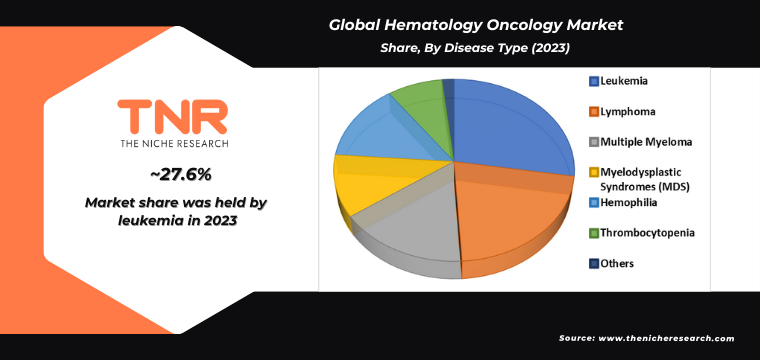
Oral segment, categorized by route of administration, has exerted significant dominance over the global hematology oncology market.
This dominance stems from several factors contributing to its appeal and widespread adoption among patients and healthcare providers alike. Oral medications offer convenience and flexibility, allowing patients to administer treatments at home without the need for frequent hospital visits. This aspect is particularly advantageous in chronic conditions like hematologic malignancies, where long-term adherence to treatment regimens is crucial for managing disease progression. Advancements in pharmaceutical formulations have improved the bioavailability and efficacy of oral therapies, enhancing their viability as primary treatment options. The oral segment’s growth is also supported by innovations in targeted therapies and molecularly targeted drugs, which continue to expand the range of oral treatments available for various types of blood cancers.
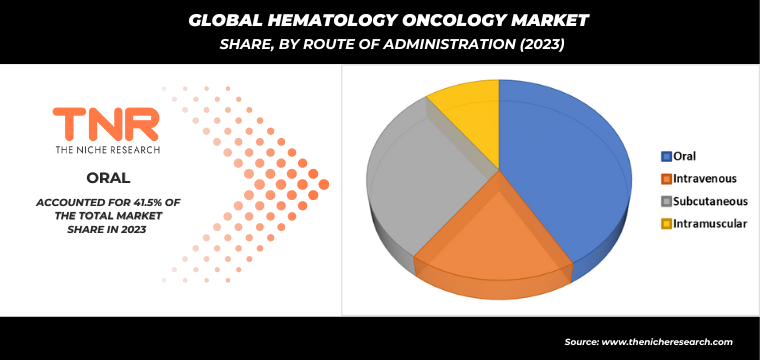
By end user, specialty clinics segment is anticipated to grow fastest over the forecast timeline.
Specialty clinics cater specifically to the diagnosis, treatment, and management of complex medical conditions, including hematologic malignancies. This anticipated growth is driven by several factors, including an increasing preference among patients for specialized care that offers comprehensive treatment options and personalized approaches. Specialty clinics often house advanced diagnostic technologies and specialized healthcare professionals with expertise in hematology oncology, which enhances patient outcomes and satisfaction.
The rise in prevalence of hematologic cancers globally, coupled with advancements in targeted therapies and immunotherapies, further fuels the demand for specialized care provided by these clinics. As healthcare systems continue to prioritize specialized treatment modalities, the specialty clinics segment is expected to expand significantly, meeting the evolving needs of patients and improving overall treatment efficacy.
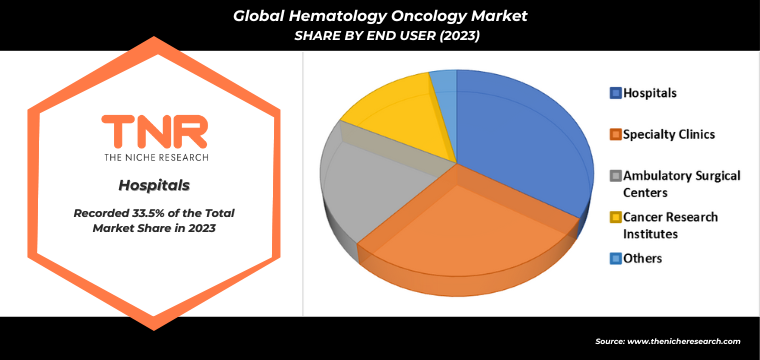
In 2023, North America solidified its dominance in the global hematology oncology market, contributing a revenue share of 36.3%.
This dominance can be attributed to several factors, including robust healthcare infrastructure, advanced diagnostic technologies, and high healthcare expenditure levels supporting extensive research and development activities. Moreover, the region benefits from a well-established regulatory framework that facilitates rapid approval and adoption of innovative therapies and treatments for hematologic malignancies. Growing prevalence of hematologic cancers, coupled with an aging population and increasing awareness among patients and healthcare providers, continues to drive market growth in North America. As the region continues to prioritize advancements in precision medicine and personalized therapies, it is expected to maintain its significant share and influence in the global hematology oncology landscape.
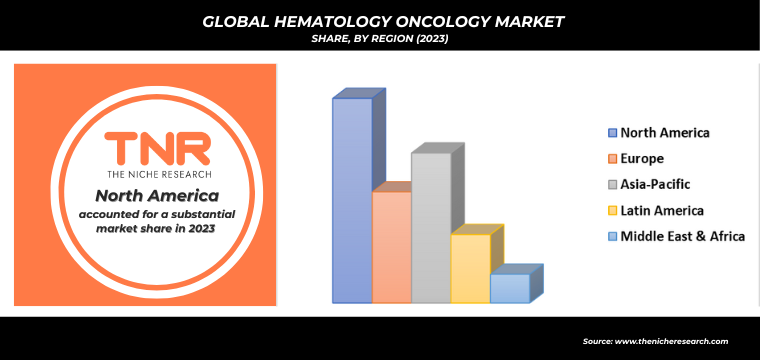
Competitive Landscape
Some of the players operating in the hematology oncology market are
- AbbVie Inc.
- Astellas Pharma Co., Limited
- AstraZeneca
- Bayer AG
- Bristol-Myers Squibb
- Eli Lilly and Company
- GSK plc.
- Janssen Pharmaceuticals
- Merck & Co., Inc.
- Novartis AG
- Pfizer Inc.
- Takeda Pharmaceutical Company Limited
- Teva Pharmaceutical Industries Ltd.
- Other Industry Participants
Global Hematology Oncology Market Scope
| Report Specifications | Details |
| Market Revenue in 2023 | US$ 10.5 Bn |
| Market Size Forecast by 2034 | US$ 24.7 Bn |
| Growth Rate (CAGR) | 8.1% |
| Historic Data | 2016 – 2022 |
| Base Year for Estimation | 2023 |
| Forecast Period | 2024 – 2034 |
| Report Inclusions | Market Size & Estimates, Market Dynamics, Competitive Scenario, Trends, Growth Factors, Market Determinants, Key Investment Segmentation, Product/Service/Solutions Benchmarking |
| Segments Covered | By Treatment Type, By Disease Type, By Route of Administration, By End User, By Region |
| Regions Covered | North America, Europe, Asia Pacific, Middle East & Africa, Latin America |
| Countries Covered | U.S., Canada, Mexico, Rest of North America, France, The UK, Spain, Germany, Italy, Nordic Countries (Denmark, Finland, Iceland, Sweden, Norway), Benelux Union (Belgium, The Netherlands, Luxembourg), Rest of Europe, China, Japan, India, New Zealand, Australia, South Korea, Southeast Asia (Indonesia, Thailand, Malaysia, Singapore, Rest of Southeast Asia), Rest of Asia Pacific, Saudi Arabia, UAE, Egypt, Kuwait, South Africa, Rest of Middle East & Africa, Brazil, Argentina, Rest of Latin America |
| Key Players | AbbVie Inc., Astellas Pharma Co., Limited, AstraZeneca, Bayer AG, Bristol-Myers Squibb, Eli Lilly and Company, GSK plc., Janssen Pharmaceuticals, Merck & Co., Inc., Novartis AG, Pfizer Inc., Takeda Pharmaceutical Company Limited, Teva Pharmaceutical Industries Ltd. |
| Customization Scope | Customization allows for the inclusion/modification of content pertaining to geographical regions, countries, and specific market segments. |
| Pricing & Procurement Options | Explore purchase options tailored to your specific research requirements |
| Contact Details | Consult With Our Expert
Japan (Toll-Free): +81 663-386-8111 South Korea (Toll-Free): +82-808- 703-126 Saudi Arabia (Toll-Free): +966 800-850-1643 United Kingdom: +44 753-710-5080 United States: +1 302-232-5106 E-mail: askanexpert@thenicheresearch.com
|
Global Hematology Oncology Market
By Treatment Type
- Targeted therapy
- Chemotherapy
- Radiation therapy
- Immunotherapy
- Stem cell transplantation
- Others
By Disease Type
- Leukemia
- Lymphoma
- Multiple Myeloma
- Myelodysplastic Syndromes (MDS)
- Hemophilia
- Thrombocytopenia
- Others
By Route of Administration
- Oral
- Intravenous
- Subcutaneous
- Intramuscular
By End User
- Hospitals
- Specialty Clinics
- Ambulatory Surgical Centers
- Cancer Research Institutes
- Others
By Region
- North America (U.S., Canada, Mexico, Rest of North America)
- Europe (France, The UK, Spain, Germany, Italy, Nordic Countries (Denmark, Finland, Iceland, Sweden, Norway), Benelux Union (Belgium, The Netherlands, Luxembourg), Rest of Europe)
- Asia Pacific (China, Japan, India, New Zealand, Australia, South Korea, Southeast Asia (Indonesia, Thailand, Malaysia, Singapore, Rest of Southeast Asia), Rest of Asia Pacific)
- Middle East & Africa (Saudi Arabia, UAE, Egypt, Kuwait, South Africa, Rest of Middle East & Africa)
- Latin America (Brazil, Argentina, Rest of Latin America)
Report Layout:
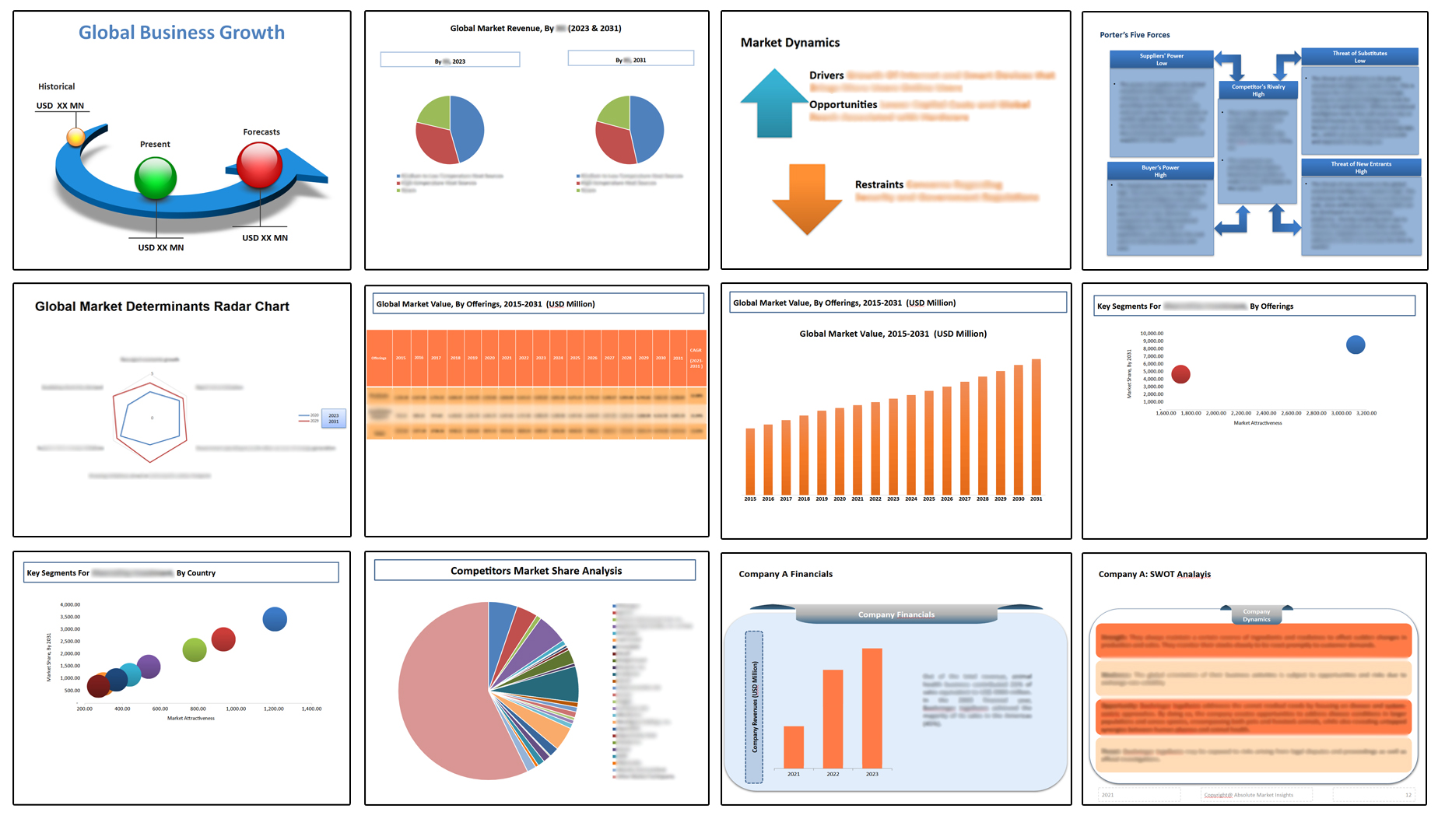
Table of Contents
Note: This ToC is tentative and can be changed according to the research study conducted during the course of report completion.
**Exclusive for Multi-User and Enterprise User.
Global Hematology Oncology Market
By Treatment Type
- Targeted therapy
- Chemotherapy
- Radiation therapy
- Immunotherapy
- Stem cell transplantation
- Others
By Disease Type
- Leukemia
- Lymphoma
- Multiple Myeloma
- Myelodysplastic Syndromes (MDS)
- Hemophilia
- Thrombocytopenia
- Others
By Route of Administration
- Oral
- Intravenous
- Subcutaneous
- Intramuscular
By End User
- Hospitals
- Specialty Clinics
- Ambulatory Surgical Centers
- Cancer Research Institutes
- Others
By Region
- North America (U.S., Canada, Mexico, Rest of North America)
- Europe (France, The UK, Spain, Germany, Italy, Nordic Countries (Denmark, Finland, Iceland, Sweden, Norway), Benelux Union (Belgium, The Netherlands, Luxembourg), Rest of Europe)
- Asia Pacific (China, Japan, India, New Zealand, Australia, South Korea, Southeast Asia (Indonesia, Thailand, Malaysia, Singapore, Rest of Southeast Asia), Rest of Asia Pacific)
- Middle East & Africa (Saudi Arabia, UAE, Egypt, Kuwait, South Africa, Rest of Middle East & Africa)
- Latin America (Brazil, Argentina, Rest of Latin America)
The Niche Research approach encompasses both primary and secondary research methods to provide comprehensive insights. While primary research is the cornerstone of our studies, we also incorporate secondary research sources such as company annual reports, premium industry databases, press releases, industry journals, and white papers.
Within our primary research, we actively engage with various industry stakeholders, conducting paid interviews and surveys. Our meticulous analysis extends to every market participant in major countries, allowing us to thoroughly examine their portfolios, calculate market shares, and segment revenues.
Our data collection primarily focuses on individual countries within our research scope, enabling us to estimate regional market sizes. Typically, we employ a bottom-up approach, meticulously tracking trends in different countries. We analyze growth drivers, constraints, technological innovations, and opportunities for each country, ultimately arriving at regional figures.Our process begins by examining the growth prospects of each country. Building upon these insights, we project growth and trends for the entire region. Finally, we utilize our proprietary model to refine estimations and forecasts.
Our data validation standards are integral to ensuring the reliability and accuracy of our research findings. Here’s a breakdown of our data validation processes and the stakeholders we engage with during our primary research:
- Supply Side Analysis: We initiate a supply side analysis by directly contacting market participants, through telephonic interviews and questionnaires containing both open-ended and close-ended questions. We gather information on their portfolios, segment revenues, developments, and growth strategies.
- Demand Side Analysis: To gain insights into adoption trends and consumer preferences, we reach out to target customers and users (non-vendors). This information forms a vital part of the qualitative analysis section of our reports, covering market dynamics, adoption trends, consumer behavior, spending patterns, and other related aspects.
- Consultant Insights: We tap into the expertise of our partner consultants from around the world to obtain their unique viewpoints and perspectives. Their insights contribute to a well-rounded understanding of the markets under investigation.
- In-House Validation: To ensure data accuracy and reliability, we conduct cross-validation of data points and information through our in-house team of consultants and utilize advanced data modeling tools for thorough verification.
The forecasts we provide are based on a comprehensive assessment of various factors, including:
- Market Trends and Past Performance (Last Five Years): We accurately analyze market trends and performance data from preceding five years to identify historical patterns and understand the market’s evolution.
- Historical Performance and Growth of Market Participants: We assess the historical performance and growth trajectories of key market participants. This analysis provides insights into the competitive landscape and individual company strategies.
- Market Determinants Impact Analysis (Next Eight Years): We conduct a rigorous analysis of the factors that are projected to influence the market over the next eight years. This includes assessing both internal and external determinants that can shape market dynamics.
- Drivers and Challenges for the Forecast Period:Identify the factors expected to drive market growth during the forecast period, as well as the challenges that the industry may face. This analysis aids in deriving an accurate growth rate projection.
- New Acquisitions, Collaborations, or Partnerships: We keep a close watch on any new acquisitions, collaborations, or partnerships within the industry. These developments can have a significant impact on market dynamics and competitiveness.
- Macro and Micro Factors Analysis:A thorough examination of both macro-level factors (e.g., economic trends, regulatory changes) and micro-level factors (e.g., technological advancements, consumer preferences) that may influence the market during the forecast period.
- End-User Sentiment Analysis: To understand the market from the end-user perspective, we conduct sentiment analysis. This involves assessing the sentiment, preferences, and feedback of the end-users, which can provide valuable insights into market trends.
- Perspective of Primary Participants: Insights gathered directly from primary research participants play a crucial role in shaping our forecasts. Their perspectives and experiences provide valuable qualitative data.
- Year-on-Year Growth Trend: We utilize a year-on-year growth trend based on historical market growth and expected future trends. This helps in formulating our growth projections, aligning them with the market’s historical performance.
Research process adopted by TNR involves multiple stages, including data collection, validation, quality checks, and presentation. It’s crucial that the data and information we provide add value to your existing market understanding and expertise. We have also established partnerships with business consulting, research, and survey organizations across regions and globally to collaborate on regional analysis and data validation, ensuring the highest level of accuracy and reliability in our reports.









